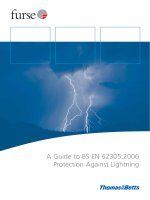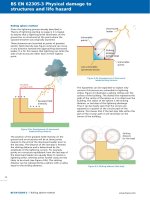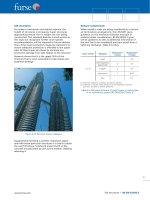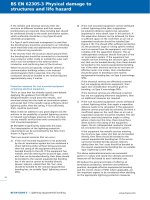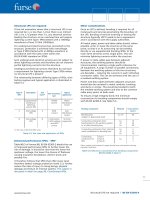Bsi bs en 01335 3 2009
Bạn đang xem bản rút gọn của tài liệu. Xem và tải ngay bản đầy đủ của tài liệu tại đây (1.35 MB, 30 trang )
BRITISH STANDARD
Office furniture —
Office work chair
Part 3: Test methods
ICS 13.180; 97.140
NO COPYING WITHOUT BSI PERMISSION EXCEPT AS PERMITTED BY COPYRIGHT LAW
BS EN
1335-3:2009
BS EN 1335-3:2009
National foreword
This British Standard is the UK implementation of EN 1335-3:2009. It
supersedes BS EN 1335-3:2000 which is withdrawn.
The UK participation in its preparation was entrusted to Technical
Committee FW/0/3, Office.
A list of organizations represented on this committee can be obtained on
request to its secretary.
This publication does not purport to include all the necessary provisions
of a contract. Users are responsible for its correct application.
Compliance with a British Standard cannot confer immunity
from legal obligations.
This British Standard
was published under the
authority of the Standards
Policy and Strategy
Committee on 30 April
2009
© BSI 2009
ISBN 978 0 580 58649 1
Amendments/corrigenda issued since publication
Date
Comments
BS EN 1335-3:2009
EUROPEAN STANDARD
EN 1335-3
NORME EUROPÉENNE
EUROPÄISCHE NORM
April 2009
ICS 97.140
Supersedes EN 1335-3:2000
English Version
Office furniture - Office work chair - Part 3: Test methods
Mobilier de bureau - Sièges de travail de bureau - Partie 3:
Méthodes d'essai
Büromöbel - Büro-Arbeitsstuhl - Teil 3: Prüfverfahren
This European Standard was approved by CEN on 28 February 2009.
CEN members are bound to comply with the CEN/CENELEC Internal Regulations which stipulate the conditions for giving this European
Standard the status of a national standard without any alteration. Up-to-date lists and bibliographical references concerning such national
standards may be obtained on application to the CEN Management Centre or to any CEN member.
This European Standard exists in three official versions (English, French, German). A version in any other language made by translation
under the responsibility of a CEN member into its own language and notified to the CEN Management Centre has the same status as the
official versions.
CEN members are the national standards bodies of Austria, Belgium, Bulgaria, Cyprus, Czech Republic, Denmark, Estonia, Finland,
France, Germany, Greece, Hungary, Iceland, Ireland, Italy, Latvia, Lithuania, Luxembourg, Malta, Netherlands, Norway, Poland, Portugal,
Romania, Slovakia, Slovenia, Spain, Sweden, Switzerland and United Kingdom.
EUROPEAN COMMITTEE FOR STANDARDIZATION
COMITÉ EUROPÉEN DE NORMALISATION
EUROPÄISCHES KOMITEE FÜR NORMUNG
Management Centre: Avenue Marnix 17, B-1000 Brussels
© 2009 CEN
All rights of exploitation in any form and by any means reserved
worldwide for CEN national Members.
Ref. No. EN 1335-3:2009: E
BS EN 1335-3:2009
EN 1335-3:2009 (E)
Contents
Page
Foreword ..............................................................................................................................................................3
1
Scope ......................................................................................................................................................4
2
Normative references ............................................................................................................................4
3
Terms and definitions ...........................................................................................................................4
4
4.1
4.2
4.3
4.4
4.5
4.6
General test conditions .........................................................................................................................5
Preliminary preparation ........................................................................................................................5
Test equipment ......................................................................................................................................5
Application of forces .............................................................................................................................5
Tolerances ..............................................................................................................................................6
Sequence of testing ...............................................................................................................................6
Inspection and assessment of results ................................................................................................6
5
5.1
5.2
5.3
5.4
5.5
5.6
5.7
5.8
5.9
5.10
5.11
Test apparatus .......................................................................................................................................8
Test surface ............................................................................................................................................8
Stops .......................................................................................................................................................8
Seat loading pad ....................................................................................................................................8
Smaller seat loading pad ......................................................................................................................8
Local loading pad ..................................................................................................................................9
Back loading pad ...................................................................................................................................9
Arm rest durability test apparatus .................................................................................................... 10
Strap ..................................................................................................................................................... 10
Stability loading device ...................................................................................................................... 10
Loading discs ...................................................................................................................................... 11
Test surface for castor durability (and rolling resistance of the unloaded chair) ....................... 11
6
6.1
6.2
6.3
6.4
6.5
6.6
6.7
6.8
6.9
Loading points .................................................................................................................................... 11
Loading point "A" ............................................................................................................................... 11
Loading point "B" ............................................................................................................................... 11
Loading point "C" ............................................................................................................................... 11
Loading point "D" ............................................................................................................................... 11
Loading point "E" ............................................................................................................................... 12
Loading point "F"................................................................................................................................ 12
Loading point "G" ............................................................................................................................... 12
Loading point "H" ............................................................................................................................... 12
Loading point "J" ................................................................................................................................ 12
7
7.1
7.2
7.3
7.4
Tests methods..................................................................................................................................... 13
Stability ................................................................................................................................................ 13
Static load tests .................................................................................................................................. 17
Durability tests .................................................................................................................................... 19
Rolling resistance of the unloaded chair ......................................................................................... 21
8
Test report ........................................................................................................................................... 21
Annex A (normative) Seat loading pad data .................................................................................................. 23
Annex B (normative) Stability loading device data ...................................................................................... 25
Annex C (informative) Loads, masses and cycles for functional tests ...................................................... 27
2
BS EN 1335-3:2009
EN 1335-3:2009 (E)
Foreword
This document (EN 1335-3:2009) has been prepared by Technical Committee CEN/TC 207 “Furnitures”, the
secretariat of which is held by UNI.
This European Standard shall be given the status of a national standard, either by publication of an identical
text or by endorsement, at the latest by October 2009, and conflicting national standards shall be withdrawn at
the latest by October 2009.
Attention is drawn to the possibility that some of the elements of this document may be the subject of patent
rights. CEN [and/or CENELEC] shall not be held responsible for identifying any or all such patent rights.
This document supersedes EN 1335-3:2000.
This series consist of following parts:
EN 1335-1, Office furniture — Office work chair — Part 1: Dimensions — Determination of dimensions;
EN 1335-2, Office furniture — Office work chair — Part 2: Safety requirements;
EN 1335-3, Office furniture — Office work chair — Part 3: Test methods.
www.bzfxw.com
The main changes with respect to the previous edition are listed below:
a)
ISO 21015:2007 has been adopted as far as possible;
b)
loads and cycles for the safety tests have been moved to EN 1335-2;
c)
Annex C includes loads and cycles for functional tests;
d)
seat and back durability test procedures have been significantly changed;
e)
determination of the maximum offset of the backrest has been deleted.
According to the CEN/CENELEC Internal Regulations, the national standards organizations of the following
countries are bound to implement this European Standard: Austria, Belgium, Bulgaria, Cyprus, Czech
Republic, Denmark, Estonia, Finland, France, Germany, Greece, Hungary, Iceland, Ireland, Italy, Latvia,
Lithuania, Luxembourg, Malta, Netherlands, Norway, Poland, Portugal, Romania, Slovakia, Slovenia, Spain,
Sweden, Switzerland and the United Kingdom.
3
BS EN 1335-3:2009
EN 1335-3:2009 (E)
1
Scope
This European Standard specifies mechanical test methods for determining the stability, strength and
durability of office work chairs.
This European Standard does not specify type approval tests for chair components.
The tests are designed to be applied to an article of furniture that is fully assembled and ready for use.
The tests consist of the application, to various parts of the item, of forces simulating normal functional use, as
well as misuse that might reasonably be expected to occur.
The tests are designed to evaluate properties without regard to materials, design/construction or
manufacturing processes.
The test results are only valid for the article tested. When the test results are intended to be applied to other
similar articles, it is important that the test specimen be representative of the production model.
Tests carried out according to this standard are intended to demonstrate the ability of the item to give
satisfactory service in its intended environment. The safety requirements are specified in EN 1335-2 and
additional loads, masses and cycles for functional tests can be found in Annex C (informative).
The tests have been developed for units/components that have not been in use. However, when properly
justified, they may be used for fault investigation.
Assessment of ageing and degradation is not included. The tests are not intended to assess the durability of
upholstery, i.e. filling materials and covers.
www.bzfxw.com
Data are given for the design of seat-loading pads in Annex A (normative) and for the design of stabilityloading pad in Annex B (normative).
2
Normative references
The following referenced documents are indispensable for the application of this document. For dated
references, only the edition cited applies. For undated references, the latest edition of the referenced
document (including any amendments) applies.
EN 1335-2:2009, Office furniture — Office work chair — Part 2: Safety requirements
3
Terms and definitions
For the purposes of this document, the following terms and definitions apply.
3.1
office work chair
piece of seating furniture for one person, with a back rest, with or without arm rests, whose upper part, which
includes the seat, can rotate in the horizontal plane and can be adjusted in height
NOTE
Other adjustments may be included.
3.2
column
office work chair component that connects the base and the seat structure
NOTE
4
A column normally incorporates a seat height adjustment and swivel mechanism.
BS EN 1335-3:2009
EN 1335-3:2009 (E)
3.3
locking device
device which inhibits the movement of the seat action and/or the back rest
3.4
arm rest length
distance between vertical lines through its front and rear edges
NOTE
In the case of an arm rest, which is not horizontal or which is curved, the length is measured in a horizontal
plane 20 mm below the highest point of the arm rest.
3.5
supporting point
castor or glide
4
4.1
General test conditions
Preliminary preparation
The unit shall be assembled and/or configured according to the instructions supplied with it. The most adverse
configuration shall be used for each test, see Table 1. For testing a range of related chair models, only worst
case(s) need to be tested. If mounting or assembly instructions are not supplied, the mounting or assembly
method shall be recorded in the test report. Fittings shall not be re-tightened unless specifically required by
the manufacturer. If the configuration must be changed to produce the worst case conditions, any retightening of the fittings shall be recorded in the test report.
www.bzfxw.com
Unless otherwise stated all tests shall be carried out on the same sample.
The tests shall be carried out in indoor ambient conditions. If during a test the temperature is outside of the
range of 15 °C to 25 °C, the maximum and/or minimum temperature shall be recorded in the test report.
In the case of designs not addressed in the test procedures, the test shall be carried out as far as possible as
described, and deviations from the test procedure recorded in the test report.
Before beginning the testing, visually inspect the unit thoroughly. Record any defects so that they are not
assumed to have been caused by the tests. Carry out measurements if specified.
4.2
Test equipment
Unless otherwise specified, the tests may be applied by any suitable device because results are dependent
only upon correctly applied forces and not on the apparatus.
The equipment shall not inhibit deformation nor cause unnatural deformation of the unit/component, i.e. it shall
be able to move so that it can follow the deformation of the unit/component during testing.
All loading pads shall be capable of pivoting in relation to the direction of the applied force. The pivot point
shall be as close as practically possible to the load surface.
If a loading pad tends to slide use a slip resistant material between the loading pad and the surface being
tested.
4.3
Application of forces
The forces in the static load tests shall be applied sufficiently slowly to ensure that negligible dynamic force is
applied. Each force shall be maintained for not less than 10 s and not more than 15 s.
5
BS EN 1335-3:2009
EN 1335-3:2009 (E)
The forces in durability tests shall be applied at a rate to ensure that excessive heating does not occur. Each
force shall be maintained for (2 ± 1) s.
The forces may be applied using masses.
4.4
Tolerances
Unless otherwise stated, the following tolerances are applicable:
Forces:
± 5 % of the nominal force
Masses:
± 1 % of the nominal mass
Dimensions: ± 5 mm of the nominal dimension on soft surfaces
± 1 mm of the nominal dimension on all other surfaces
Angles:
± 2° of the nominal angle
The accuracy for the positioning of loading pads shall be ± 5 mm.
The tests specify the application of forces. Masses may, however, be used. The relation 10 N for 1 kg may be
used for this purpose.
4.5
Sequence of testing
All applicable tests shall be carried out on the same sample.
The sequence of the safety tests shall be as specified in EN 1335-2:2009, 4.2.
www.bzfxw.com
If functional tests shall be carried out, this shall be done in the sequence of Table C.1 after completing all the
safety tests specified in EN 1335-2.
4.6
Inspection and assessment of results
After completion of each test, inspect the unit again. Record any changes including:
a)
fracture of any component or joint;
b)
loosening of any joint intended to be rigid, which can be demonstrated by hand pressure;
c)
deformation or wear of any part or component such that its function is impaired;
d)
loosening of any means of fixing components to the unit;
e)
changes that may affect stability.
6
BS EN 1335-3:2009
EN 1335-3:2009 (E)
Table 1 — Positioning of chair components
Clause
Test
Seat height
Seat
Back rest
in height
Back rest
in depth
Tilt stiffness
adjustment
Castors and
base
Arm rest
Foot rest
7.1.1
Front edge overturning
highest position
foremost
position
highest
position
foremost
position
maximum
tension
most likely to
cause
overturning
most likely to
cause
overturning
7.1.2
Forward overturning
highest position
foremost
position
highest
position
foremost
position
maximum
tension
most likely to
cause
overturning
most likely to
cause
overturning
---
7.1.3
forward overturning for chairs
with foot rest
highest position
foremost
position
lowest
position
foremost
position
maximum
tension
most likely to
cause
overturning
most likely to
cause
overturning
most likely
to cause
overturning
7.1.4
Sideways overturning for
chairs without arm rests
highest position
foremost
position
highest
position
foremost
position
maximum
tension
most likely to
cause
overturning
---
---
7.1.5
Sideways overturning for
chairs with arm rests
highest position
foremost
position
highest
position
foremost
position
maximum
tension
most likely to
cause
overturning
most likely to
cause
overturning
---
7.1.6
Rearwards overturning of
chairs without back rest
inclination
highest position
rearmost
position
highest
position
rearmost
position
minimum
tension
most likely to
cause
overturning
most likely to
cause
overturning
---
7.1.7
Rearwards overturning of
chairs with back rest
inclination
highest position
rearmost
position
highest
position
rearmost
position
minimum
tension
most likely to
cause
overturning
most likely to
cause
overturning
---
7.2.1
Seat front edge static load
test
highest position
foremost
position
---
---
---
---
---
---
7.2.2
Combined seat and back
static load
highest position
most
adverse
position
highest
position
rearmost
position
mid range
least likely to
cause
overturning
---
---
7.2.3
Arm rest downward static
load test – central
lowest position
horizontal
7.2.4
Arm rest downward static
load test – front
lowest position
horizontal
7.2.5
Arm rest sideways static load
test
lowest position
7.2.6
Foot rest static load test
7.3.1
www.bzfxw.com
---
---
---
---
most likely to
cause failure
---
---
---
---
---
highest,
foremost
position
---
horizontal
---
---
---
---
highest,
widest
position
---
---
---
---
---
---
least likely to
cause
overturning
---
highest
position
Seat and back durability
highest position
horizontal
highest
position
most likely
to cause
failure
mid range
90° to the base
arm
---
---
7.3.2
Arm rest durability
lowest position
horizontal
---
---
maximum
tension
---
highest,
widest
position
---
7.3.3
Swivel test
highest position
horizontal,
foremost
position
highest
position
rearmost
position
---
---
---
---
7.3.4
Foot rest durability
---
---
---
---
---
least likely to
cause
overturning
---
lowest
position
7.3.5
Castor durability
lowest position
horizontal
---
---
---
---
---
---
7
BS EN 1335-3:2009
EN 1335-3:2009 (E)
5
5.1
Test apparatus
Test surface
A rigid, horizontal and flat surface.
5.2
Stops
Devices to prevent the chair from sliding or rolling but not overturning. They shall be 3 mm high for stability
tests and 12 mm high for all other tests, except in cases where the design of the chair or the test method
necessitates the use of higher stops, in which case the lowest that will prevent the chair from sliding or rolling,
shall be used.
5.3
Seat loading pad
The seat loading pad is a naturalistically shaped rigid indenter with a hard, smooth surface, see Figure 1. In
principle, this loading pad is for use in loading points "A" (6.1) and "C" (6.3), see Figure 6. For details of the
design see Annex A.
www.bzfxw.com
Key
a loading point
Figure 1 — Seat loading pad - principle
5.4
Smaller seat loading pad
The smaller seat loading pad is a rigid, circular object 200 mm in diameter, the face of which has a convex
spherical curvature of 300 mm radius with a 12 mm blend radius between the face and the side, see Figure 2.
In principle, this loading pad shall be used in loading points "D" (6.4), "G" (6.7), "F" (6.6) and "J" (6.9), see
Figure 6.
8
BS EN 1335-3:2009
EN 1335-3:2009 (E)
Dimensions in millimetres
Figure 2 — Smaller seat loading pad
5.5
Local loading pad
The local loading pad is a rigid, circular object 100 mm in diameter, with a flat face and a 12 mm blend radius
between the face and the side.
5.6
Back loading pad
The back loading pad is a rigid rectangular object 200 mm high and 250 mm wide, the face of which is curved
across the width of the pad with a convex cylindrical curvature of 450 mm radius and with a 12 mm blend
radius between the face and the sides, see Figure 3.
Dimensions in millimetres
Figure 3 — Back loading pad
9
BS EN 1335-3:2009
EN 1335-3:2009 (E)
5.7
Arm rest durability test apparatus
An apparatus capable of applying a cyclic force simultaneously to both arm rests. The forces shall be applied
through an arm rest loading device in principle functioning as shown in Figure 4.
Dimensions in millimetres
Figure 4 — Arm rest test principle
The apparatus shall be capable of applying the forces at varying angles to the vertical. It shall be adjustable
both vertically and horizontally and set as specified in 7.3.2. The apparatus shall be capable of freely following
the deformation of the arm rests during testing. The length of the loading pad shall be 100 mm with the force
acting through the centre of its length.
5.8
Strap
A 50 mm wide strap capable of bearing a mass as specified in EN 1335-2:2009, Table A.1.
5.9
Stability loading device
A loading device in principle functioning as shown in Figure 5. For details of the design see Annex B.
10
BS EN 1335-3:2009
EN 1335-3:2009 (E)
Key
a hold down strap
b centreline of seat
c
for details see Figure B.1
d for details see Figure B.2
Figure 5 — Stability loading device – principle
5.10 Loading discs
Loading discs each with a mass of 10 kg, a diameter of 350 mm and a thickness of 48 mm. The centre of
gravity shall be in the centre of the disc.
5.11 Test surface for castor durability (and rolling resistance of the unloaded chair)
A horizontal smooth steel surface.
6
6.1
Loading points
Loading point "A"
The point in which the chair's axis of rotation intersects with the seat surface with the seat in a position as
close as possible to the horizontal.
6.2
Loading point "B"
The point on the centreline of the back rest, 300 mm above loading point “A” (6.1) measured when the seat is
loaded with 640 N through the seat loading pad.
6.3
Loading point "C"
A point in front of loading point “A” (6.1) along the centre line of the seat, 100 mm from the edge of the load
bearing structure of the seat.
6.4
Loading point "D"
The point 150 mm to the right of loading point “A” (6.1).
11
BS EN 1335-3:2009
EN 1335-3:2009 (E)
6.5
Loading point "E"
The point 50 mm to the right of loading point “B” (6.2).
6.6
Loading point "F"
A point in front of loading point "D" (6.4) on a line parallel to the centre line, 100 mm from the edge of the load
bearing structure of the seat.
6.7
Loading point "G"
The point 150 mm to the left of loading point “A” (6.1).
6.8
Loading point "H"
The point 50 mm to the left of loading point “B” (6.2).
6.9
Loading point "J"
A point in front of loading point "G" (6.7) on a line parallel to the centre line, 100 mm from the structure of the
seat edge.
Dimensions in millimetres
Key
A loading point "A"
B loading point "B"
C loading point "C"
D
E
F
loading point "D"
loading point "E"
loading point "F"
G
H
J
Figure 6 — Loading points
12
loading point "G"
loading point "H"
loading point "J"
BS EN 1335-3:2009
EN 1335-3:2009 (E)
7
Tests methods
7.1
Stability
Position the chair on the test surface (see 5.1) with its components as specified in 4.1 and Table 1.
Record whether the chair overturns during the tests in 7.1.1 to 7.1.7.
7.1.1
Front edge overturning
Do not position the chair with the stops against the supporting points (3.5). Fix the strap (5.8) to the chair as
shown in Figure 7, i.e. the force is applied at the point on the front edge that is furthest from the axis of
rotation, and allow the mass M1 to hang freely (see Figure 7).
Key
a position of the strap on the seat surface
b the tilting axis, castors in the most adverse position
Figure 7 — Front edge overturning
7.1.2
Forwards overturning
Position the chair with two adjacent supporting points (3.5) on the front against the stops (5.2).
Apply by means of the stability loading device (5.9) a vertical force F1 acting 60 mm from the front edge of the
load bearing structure of the seat at those points most likely to result in overturning. Apply for at least 5 s a
horizontal outwards force F2 from the point on the seat surface where the vertical force is applied (see
Figure 8).
13
BS EN 1335-3:2009
EN 1335-3:2009 (E)
Dimensions in millimetres
Key
F1 vertical force
F2 horizontal force
7.1.3
Figure 8 — Forward overturning
Forwards overturning for chairs with footrest
For chairs with footrests repeat the principle of 7.1.2 on the footrest. For round cross section ring shaped
footrests, the vertical force F1 shall be applied through the centre of the ring cross section.
7.1.4
Sideways overturning for chairs without arm rests
Position the chair with two adjacent supporting points (3.5) on one side against the stops (5.2).
Apply by means of the stability loading device (5.9) a vertical force F1 acting 60 mm from the side edge of the
load bearing structure of the seat at those points most likely to result in overturning. Apply for at least 5 s a
horizontal sideways force F2 outwards from the point on the seat surface where the vertical force is applied,
(see Figure 9).
Dimensions in millimetres
Key
F1 vertical force
F2 horizontal force
14
Figure 9 — Sideways overturning for chairs without arm rests
BS EN 1335-3:2009
EN 1335-3:2009 (E)
7.1.5
Sideways overturning for chairs with arm rests
Position the chair with two adjacent supporting points (3.5) on one side against the stops (5.2).
Apply by means of the stability loading device (5.9) a vertical force F1 acting at a point 100 mm from the fore
and aft centre line of the seat at the side where the supporting points (3.5) are restrained (see Figure 10) and
between 175 mm and 250 mm forward of the rear edge of the seat. Apply a vertical downward force F2 acting
at points on the arm rest which is on the same side as the restrained supporting points (3.5) up to a maximum
40 mm inwards from the outer edge of the upper surface of the arm rest, but not beyond the centre of the arm
rest, and at the most adverse position along its length. Apply a horizontal sideways force F3 outwards from the
same point for at least 5 s (see Figure 10).
Dimensions in millimetres
Key
A
F1
F2
F3
seat loading point (6.1)
vertical force
vertical force
horizontal force
Figure 10 — Sideways overturning for chairs with arm rests
7.1.6
Rearwards overturning for chairs without back rest inclination
Position the chair with two adjacent supporting points (3.5) on the back against the stops (5.2). When an
independent lumbar adjustment is fitted it shall be set in the most adverse configuration.
A vertical force F1 shall be applied at point "A" (6.1) and a horizontal force F2 shall be applied at point "B"
(6.2), (see Figure 11).
If the back rest pad is pivoting around a horizontal axis above the height of the seat and is free to move, the
horizontal force shall be applied on the axis. If height adjustable, the axis shall be set as close as possible to
300 mm above point "A" (6.1).
15
BS EN 1335-3:2009
EN 1335-3:2009 (E)
Dimensions in millimetres
Key
A
B
F1
F2
seat loading point (6.1)
back loading point (6.2)
vertical force
horizontal force
Figure 11 — Rearward overturning for chairs without back rest inclination
7.1.7
Rearwards overturning for chairs with adjustable back rest inclination
Do not position the chair with the supporting points (3.5) against the stops (5.2). When an independent lumbar
adjustment is fitted it shall be set in the most adverse configuration.
Load the chair with discs (5.10) so that the discs are firmly settled against the back rest (see Figure 12). If the
height of the stack of discs exceeds the height of the back rest, prevent the upper discs from sliding off by the
use of a light support.
Figure 12 — Rearward overturning for chairs with adjustable back rest inclination
16
BS EN 1335-3:2009
EN 1335-3:2009 (E)
7.2
Static load tests
Position the chair and its components as specified in 4.1 and Table 1 on the test surface (5.1).
7.2.1
Seat front edge static load test
Position the smaller seat loading pad (5.4) at loading point "F" or "J" (6.6 or 6.9). Apply a vertical downward
force F1 through the centre of the loading pad.
7.2.2
Combined seat and back static load test
Prevent the chair from moving rearwards by placing stops (5.2) behind two adjacent supporting points (3.5) at
the rear of the chair.
Chairs with a locking device(s) for seat and/or back rest angle movements shall be tested first with the
device(s) locked for half of the cycles and then with the device(s) unlocked for the other half of the cycles. For
the first half of the cycles the back rest shall be in the upright position.
Apply a vertical force F1 through the seat loading pad (5.3) at point "A" (6.1). Keep the seat loaded and apply
a force F2 through the centre of the back loading pad (5.6) at point "B" (6.2). When fully loaded the force shall
act at 90° ± 10° to the back rest plane (see Figure 13). If the chair tends to overturn reduce the back rest force
and report the actual force. Remove the back force and then the seat force.
Key
A
B
F1
F2
seat loading point (6.1)
back loading point (6.2)
vertical force
perpendicular force
Figure 13 — Combined seat and back static load test
7.2.3
Arm rest downward static load test – central
The arm rests shall be loaded vertically by means of the local loading pads (5.5). The loading points shall be
at the mid point of the arm rest length (3.4) and centred side to side.
Apply the force to both arm rests simultaneously (see Figure 14).
17
BS EN 1335-3:2009
EN 1335-3:2009 (E)
Key
F
vertical force
Figure 14 — Arm rest downward static load test – central
7.2.4
Arm rest downward static load test – front
The arm rests shall be loaded vertically by means of the local loading pads (5.5). The loading points shall be
75 mm from the front edge and centred side to side.
Apply the force to both arm rests simultaneously (see Figure 15).
Key
F
vertical force
Figure 15 — Arm rest downward static load test – front
18
BS EN 1335-3:2009
EN 1335-3:2009 (E)
7.2.5
Arm rest sideways static load test
Apply an outward horizontal force to both arm rests simultaneously. Apply the forces to the edge of the arm
rest at the point along the arm rest most likely to cause failure but not less than 75 mm from the front or rear
edge (see Figure 16).
Key
F
horizontal force
Figure 16 — Arm rest sideways static load test
7.2.6
Foot rest static load test
Apply a vertical force acting 80 mm from front edge of the load bearing structure of the foot rest at those
points most likely to cause failure. For round cross section ring shaped footrests, the force shall be applied
through the centre of the ring cross section. If the chair tends to overturn load the seat to prevent overturning
and report this.
7.3
Durability tests
Position the chair and its components as specified in 4.1 and Table 1 on the test surface (5.1) except for the
castor and chair base durability test (7.3.5).
7.3.1
Seat and back durability
The upper part of the chair shall be positioned so that the centre of the back rest is midway between two
adjacent supporting points (3.5) of the base with stops (5.2) against these supporting points.
The seat load shall be applied vertically using the seat loading pad (5.3). The back rest force shall be applied
at an angle of 90° ± 10° to the back rest when fully loaded (see Figure 17) using the back loading pad (5.6).
19
BS EN 1335-3:2009
EN 1335-3:2009 (E)
Key
F perpendicular force
Figure 17 — Backrest force application – principle
All chairs shall be tested to steps 1 to 5 (see Table 2).
Chairs with a locking device(s) for seat and/or back rest angle movements shall be tested in step 2 first with
the device(s) locked for half of the cycles and then with the device(s) unlocked for the other half of the cycles.
For the first half of the cycles the back rest shall be in the upright position. In steps 3, 4 and 5 the mechanism
shall be set free to move.
One cycle shall consist of the application and removal of the force(s) at the respective loading point(s).
Each step shall be completed before going to the next.
First the seat force shall be applied and maintained while the back rest force is applied.
If the back rest pad is pivoting around a horizontal axis above the height of the seat and is free to move, the
horizontal force shall be applied on the axis. If height adjustable, the axis shall be set as close as possible to
300 mm above point "A" (6.1). If the axis cannot be adjusted to 300 mm, adjust the force to produce the same
bending moment.
Table 2 — Seat and back durability test
Step
Loading point
(see Figure 6)
7.3.2
1
A
2
C-B
3
J-E
4
F-H
5
D-G
Arm rest durability
Apply simultaneously and cyclically the force on each arm rest at points 100 mm behind the foremost point of
the arm rest length (see 3.4). Apply a force of (10 ± 5) N through a loading device in principle functioning as
shown in Figure 4. With this force applied adjust the apparatus so that each "arm" of the test apparatus has an
angle of 10° ± 1° to the vertical. The length of the "arm" of the test apparatus shall be 600 mm ± 10 mm. The
arm rests shall be allowed to deform freely.
20
BS EN 1335-3:2009
EN 1335-3:2009 (E)
7.3.3
Swivel test
The base of the chair shall be secured on a rotating table with a test surface (see 5.1) so that the rotating axis
of the chair coincides with the rotating axis of the table. The upper part of the chair shall be loosely fixed in
such a way as not to hinder the rotation of the base. Load the seat in loading point A (6.1) with a mass M1 and
in loading point C (6.3) with a mass M2 or any equivalent loading which will result in the same downwards
force and bending moment on the chair. The angle of rotation shall be 360° at a rate of (10 ± 5) cycles/minute.
Change direction after each rotation.
7.3.4
Foot rest durability
Using the local loading pad (5.5) apply a vertical downward force to the foot rest at the point most likely to
cause failure but not less than 80 mm from the front edge. For round cross section ring shaped foot rests, the
force shall be applied through the centre of the ring cross section.
7.3.5
Castor and chair base durability
This test does not apply to chairs with castors which are braked when the chair is loaded.
The chair shall be placed on a rotating table with a test surface (see 5.11) so that the rotating axis of the chair
coincides with the rotating axis of the table. Load the seat in point A with M1. The base shall be loosely fixed in
such a way that there is no rotation of the base but that the natural movements of the castors during testing
are not prevented. The castors shall be left free to swivel, the table shall be rotated with a rate of 6 cycles per
minute. The angle of rotation shall be from 0° to 180° and back. One rotation forward and one rotation
backward constitutes one cycle.
Alternatively attach the chair to a device that provides a linear movement of (1 000 ± 250) mm and a test
surface (see 5.11). Load the seat in point "A" with M1. The base shall be loosely fixed in such a way that there
is no rotation of the base but that the natural movements of the castors during testing are not prevented. The
castors shall be left free to swivel, the device shall move with a rate of 6 cycles per minute. One movement
forward and one movement backward constitutes one cycle.
NOTE
For both alternatives it is recommended to perform the test with a speed as slow as possible with a short
break when the device changes direction.
7.4
Rolling resistance of the unloaded chair
The chair shall be placed on the test surface (see 5.1) and shall be pushed or pulled over a distance of at
least 550 mm. A speed of (50 ± 5) mm/s shall be maintained over the measuring distance. The force shall be
applied at a height of (200 ± 50) mm above the test surface.
Record the force used to push or to pull the chair over the distance from 250 mm to 500 mm as the rolling
resistance.
8
Test report
The test report shall include at least the following information:
a)
reference to this standard;
b)
details of the chair tested;
c)
any defects observed before testing;
d)
test results according to Clause 7;
e)
details of any deviations from this standard;
21
BS EN 1335-3:2009
EN 1335-3:2009 (E)
f)
name and address of the test facility;
g)
dates of tests.
22
BS EN 1335-3:2009
EN 1335-3:2009 (E)
Annex A
(normative)
Seat loading pad data
The seat loading pad specified in 5.3 of this standard currently exists in two versions:
1)
machined in hardwood, as shown in Figure A.1;
2)
moulded from fibre glass, as shown in Figure A.2.
Dimensions in millimetres
Key
a axis of the cone
b centre section cross hatched
Figure A.1 — Seat loading pad geometry – Hardwood construction
23
![Đề Thi Sinh Giỏi Toán Toán 12 - THPT Diễn Châu 3 [2009 - 2010] ppsx](https://media.store123doc.com/images/document/2014_07/02/medium_ybh1404267617.jpg)


